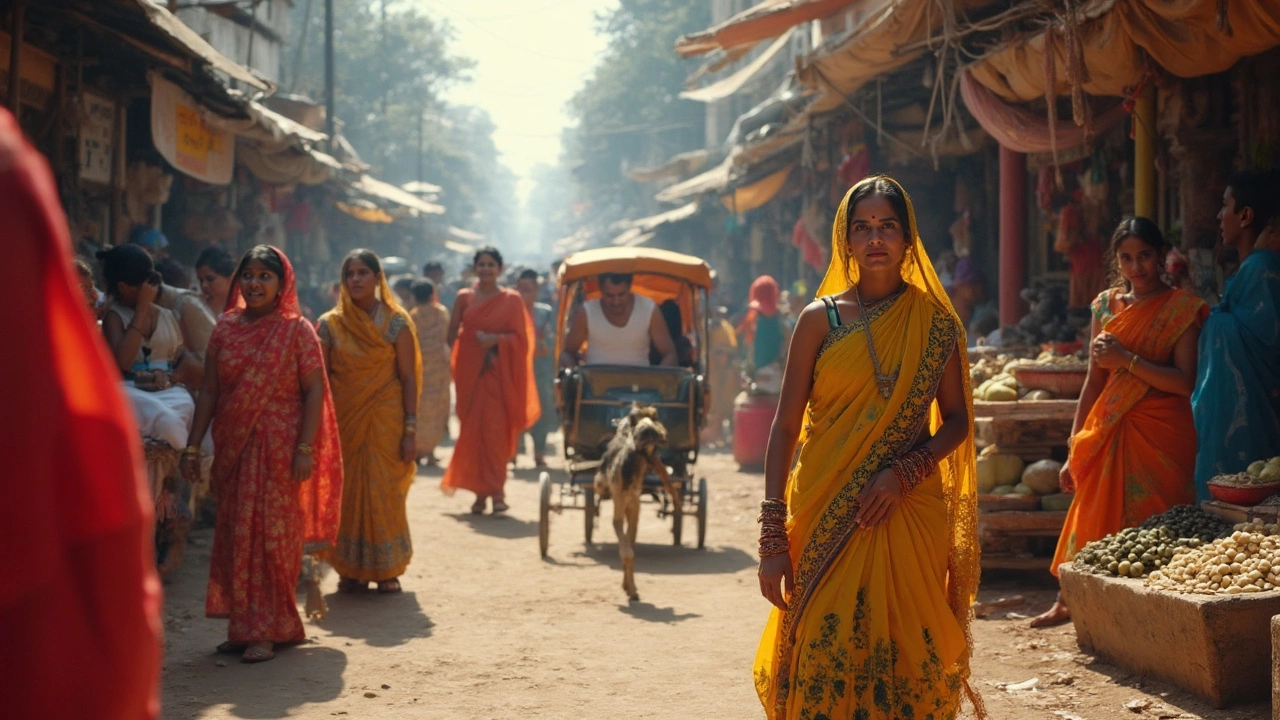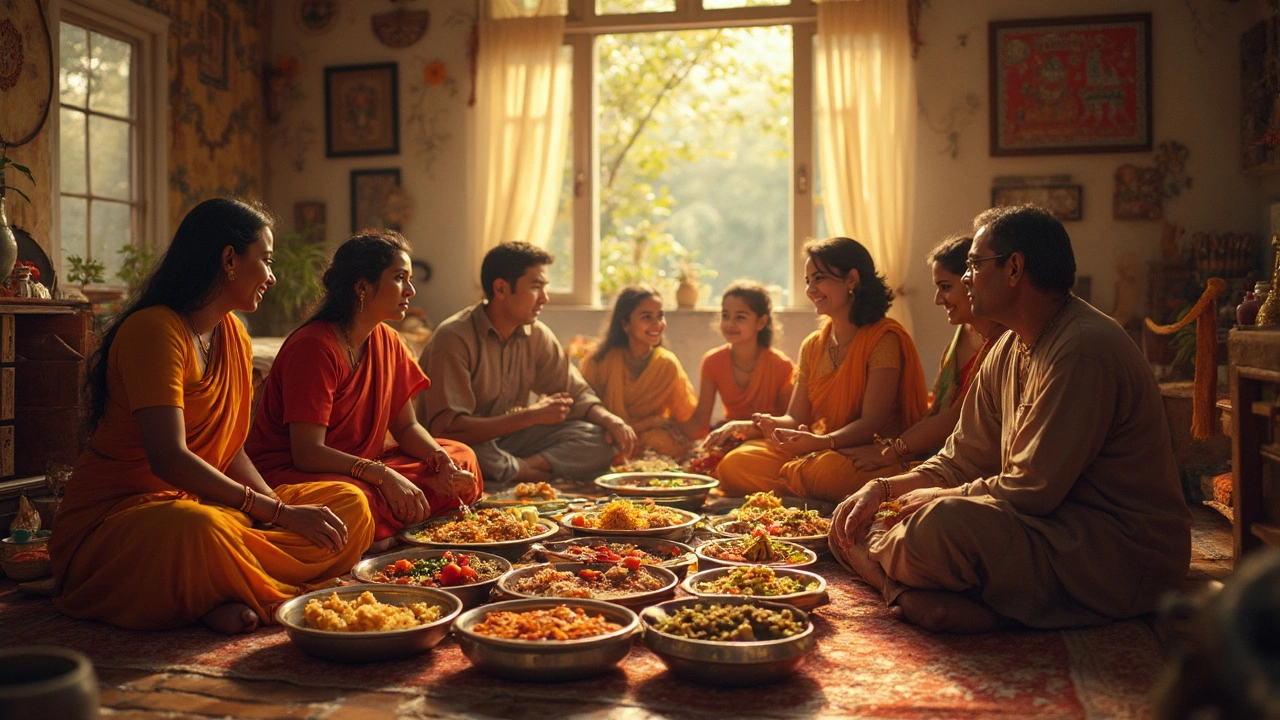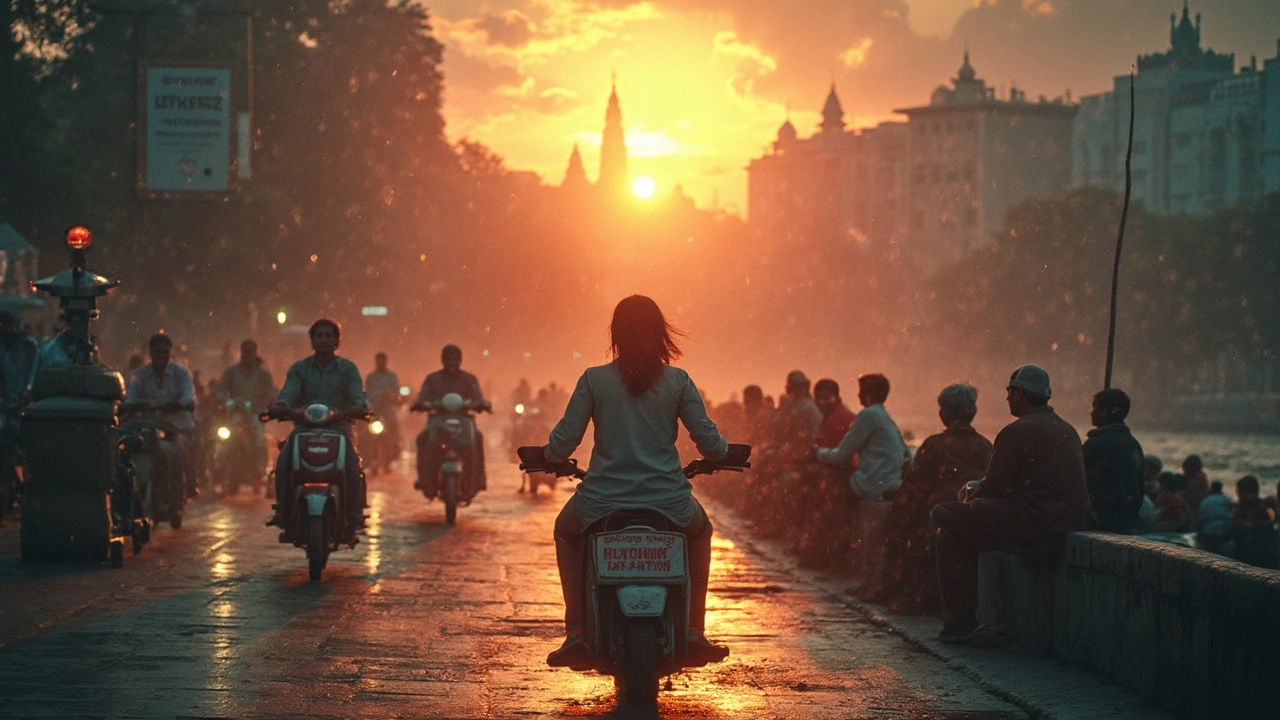What is India Most Known For? Life Status, Culture, and Curiosities Explained
 Apr, 23 2025
Apr, 23 2025
Forget about curry clichés and Bollywood dance moves—India is a heavyweight when it comes to leaving a mark on just about everyone who visits, lives here, or even watches a random Instagram reel. People in India pack their days with a mashup of ancient customs, fast-moving tech, all-night weddings, and traffic so wild that my daughter Aditi once asked if cows actually run the city (she’s half right).
If you’re trying to nail down what India is most known for, you’ve got to talk about diversity right up front. Switch states and you might as well be in a different country—different language, food, festivals, even the way people dress. It's not just lip service; there are literally 22 official languages. People grow up code-switching before they've even ridden a school bus solo.
But it's not just the culture that's famous—the daily energy is next level. Imagine neighbors chatting at the chai stall before sunrise, the unmistakable aroma of masala in the air, and families squeezing three generations (plus two parakeets) into a single household. Daily life in India clocks in as loud, loving, slightly chaotic, and totally unforgettable.
- Colorful Chaos: India's Identity Revealed
- Spices, Street Food, and Mealtime Realities
- Family, Society, and the Always-Connected Crowd
- Festivals, Routines, and a 24/7 Party
- Tips for Travelers and Future Residents
Colorful Chaos: India's Identity Revealed
When people picture India, they often think of a whirlwind of sounds, sights, and smells. That’s because the country is all about variety—across religions, regions, clothes, and even the time people eat dinner. The Indian culture is packed with extremes: peaceful temples exist just down the street from markets bursting with people and music.
Take a random street in any city, and you’ll see old and new bumping elbows—literally. Street vendors and app-based bike taxis share the lanes, while centuries-old mosques stand next to blinking modern malls. There are 22 official languages, and that’s just the tip of the iceberg. Every state acts like its own country, holding tight to its local food, language, and way of life. My friend from Chennai once joked, “Every time I talk to my Delhi cousins, it’s like another reality show.”
Religion also plays a massive role in shaping India’s identity. Hinduism, Islam, Christianity, Sikhism, and Buddhism all have a solid presence, leading to a calendar packed with festivals. And trust me, you’ll see colorful processions and get caught in traffic jams outside just about every religious event. It’s wild but also part of daily rhythms.
Here’s a quick look at India’s staggering diversity:
| Statistic | Detail |
|---|---|
| States & Union Territories | 28 States, 8 Union Territories |
| Official Languages | 22 |
| Recognized Religions | 6 Main Religions |
| Ethnic Groups | 2,000+ distinct groups |
Travelers and first-timers often ask how people even function in this much chaos. The trick is, it actually works because everyone expects the unexpected. There’s even a saying in Hindi, “Yahan sab chalta hai” (Everything goes here). The World Economic Forum once put it perfectly:
"India’s diversity means that any visitor will find themselves both charmed and challenged. No two days—or even two hours—are ever the same."
If you want to fit in or just make your way around, start with a sense of humor and patience. Don’t fight the chaos—go with it. And don’t be afraid to ask for help, because Indians are quick to offer advice even if you didn’t actually need it. That’s the beauty of it—the messier it is, the more interesting it gets.
Spices, Street Food, and Mealtime Realities
If there’s one thing everyone mentions about India, it’s the obsession with food—and trust me, it’s totally justified. Talk about Indian culture and you’ll be hard-pressed to ignore the kick of red chili, turmeric stains on your fingers, and the endless parade of vendors pushing carts loaded with snacks.
Just walk down any busy street and you’ll see what I mean: samosas frying in bubbling oil, piles of bright orange jalebis, and servers yelling out orders for chai, pani puri, or dosas. Street food isn’t just a snack here—it’s practically its own social event. And it’s cheap. For less than what you’d pay for a coffee in a western café, you can sample five different dishes, fast. Be smart though: pick the busy vendors. High turnover means fresh food and less chance of stomach trouble (this tip is gold, especially if you’ve never visited before).
Mealtime at home is different but just as central to life status in India. Family dinners are a big deal. It’s common to see everyone—from toddlers to grandparents—eating together, sharing flatbreads like roti or parathas and scooping up curries or lentils (dal). Eating with your hand isn’t unusual; actually, it’s the norm in most households. There’s a bit of a learning curve if you’re new, but kids master it early. My daughter Aditi could make a neat rice ball by the age of four—no mess, no spoon.
Here’s a quick look at street food favorites and their average prices in major Indian cities:
| Street Food | Average Price (INR) |
|---|---|
| Vada Pav | 30 |
| Pani Puri/Golgappa | 40 |
| Pav Bhaji | 60 |
| Samosa (per piece) | 15 |
| Dosa | 70 |
Tiffin culture also runs strong in cities—homemade meals delivered in dabba (steel lunchboxes) to offices or schools by dabbawalas, especially in Mumbai. That’s synced with a level of organization that’s almost legendary; Harvard Business School has even studied it. Cutting lunch costs and serving real home-cooked flavor—that’s a win in anyone’s book.
If you want to fit in with locals, build up your spice tolerance slowly. Ask for “less spicy” on your first few rounds. And remember, in India, food is more than just a meal—it’s how people show love, friendship, and hospitality every single day.

Family, Society, and the Always-Connected Crowd
Ask any Indian what sets daily life apart, and they’ll point straight to family ties. In India, joint families aren’t ancient history—they’re usually real-time, with parents, grandparents, cousins, and that one uncle everyone avoids at weddings living under one roof. It’s tight quarters, but the perks are real: built-in babysitting, home-cooked meals, instant emotional support, and the general sense that someone’s always got your back (or is about to scold you for your fashion choices).
Family isn’t just about relatives. Neighbors double as family. If you celebrate a festival, everyone in the building is likely joining in, invited or not. Birthdays, weddings, even a regular cricket match can turn into a community-wide party. There’s a never-ending feedback loop of advice, jokes, rumors, and love—sometimes more than you bargain for. That togetherness can feel overwhelming if you’re not used to it, but most Indians wouldn’t trade it for anything.
Tech and tradition mix in weird but wonderful ways here. India is the world’s biggest market for WhatsApp, and nearly every wake-up routine goes: temple, tea, phone. According to a 2024 survey by TRA, more than 88% of Indians aged 15-35 check their messages before breakfast. Grandmas send GIFs, dads forward memes, kids teach parents reels—the entire family chat group is alive 24/7.
| India Family Snapshot (2024) | Number/Percentage |
|---|---|
| Average Household Size | ~4.4 members |
| Adults Living With Parents (Age 25-35) | 62% |
| People Using WhatsApp Daily | ~530 million |
Respect for elders is taken seriously, but it isn’t all about rules and rituals. It’s about looking after your clan, visiting relatives during festivals, and sometimes even marrying who your parents pick out (yes, arranged marriages are common—and they’re not just for movies). But make no mistake, younger Indians are speaking up more. They’re making choices in love, career, and where to live while balancing the expectations that come with a connected, community-driven society.
If you’re living in India or even just visiting for a while, the one piece of advice: give in to the group chats, answer back with humor, and don’t be surprised when your neighbor sends you biryani "just because." The lines between family, friend, neighbor, and WhatsApp contact are delightfully blurry here.
Festivals, Routines, and a 24/7 Party
If you ask anyone what comes to mind when they think of India, they’ll likely say “festivals,” and they’re right. There are so many that calendars here often double as party planners. Diwali, Holi, Eid, Christmas, Pongal, and Durga Puja are just the start. You barely finish sweeping up the last confetti before the next holiday is lined up. Each festival packs its own punch—Holi comes with colored powders and water balloons, while Diwali means homes glow with rows of lamps and the sound of firecrackers lasts well past midnight.
It isn’t just about the big-ticket celebrations. Everyday life in India follows some unspoken routines—morning household prayers, fresh flower garlands at doorways, and evening chai time that doubles as a community check-in. Neighbors catch up over masala chai, and kids dash around between homework and cricket on dusty streets. Even a “regular” day can get lively fast. Don’t be surprised if a random Tuesday features wedding drums or an election rally marching right past your window. Routines and celebrations often blend together.
What makes these routines unique is how they bring people together. Meals, for instance, are more than just food—they’re mini-festivals in themselves, often shared with extended families and neighbors. It’s tough to find someone actually eating alone here, especially during special occasions.
“India’s festivals are not just cultural events—they are a living, breathing part of everyday life. Each occasion pulls together communities, big and small, and reminds us how closely tied our joy is to each other.” — Dr. Nandita Das, Cultural Anthropologist, 2023
Check out the sheer scale of Indian festivals compared to the number of public holidays around the world:
| Country | Annual Public Holidays |
|---|---|
| India | 18–21 (varies by state) |
| USA | 10 |
| UK | 8 |
| Japan | 16 |
Can you imagine the logistics? Schools close, traffic surges, and every corner has street vendors selling special festival treats. Celebrations sometimes shut down entire neighborhoods. If you plan a visit, double-check local calendars or you might get caught in a citywide parade (it happened to me—twice in one week!).
- Tip for travelers: If you want the real Indian life status experience, time your trip around a festival. Just make sure to book everything early—trains and hotels fill up fast.
- Embrace the chaos and join in the fun. Locals love teaching guests traditional dances or how to make festival sweets.
Living in India is really living on festival time—whether it’s a public holiday or just a regular day that suddenly turns into a mini-party on your street.

Tips for Travelers and Future Residents
If you're thinking about heading to India or settling in for the long run, it pays to know what you're walking into. India isn't all Taj Mahal selfies and spicy Indian culture street snacks—it's full of daily quirks, traditions, and life hacks you'll want to figure out fast.
- Crowds and Commutes: Cities like Mumbai and Delhi are packed. Public transport can be chaotic, so take it slow, keep your valuables zipped up, and if you can, try metro lines instead of buses for less chaos. Rideshares like Ola and Uber work in most major cities.
- Staying Healthy: Don't drink tap water—seriously. Buy bottled water or use a purifier, even for brushing your teeth. Street food is legendary, but stick to stalls with big crowds (busy spots usually mean fresher food).
- Cash Still Matters: Cards and UPI apps (like Paytm and Google Pay) are everywhere in cities, but many small towns still run on good old-fashioned rupees. Keep a mix of cash and digital payment options.
- Dress Code: While cities are more relaxed, modest clothing is the default everywhere else, especially at temples or during festivals. Women often wear scarves or dupattas in sensitive areas. It just wins you points with locals and saves you from unwanted stares.
- Learning the Basics: You don’t have to speak Hindi—but knowing a few words (like "namaste," "kitna," and "paani") or a regional greeting goes a long way. People warm up when you try.
One quick fact that shocks most visitors: India’s mobile data is one of the cheapest in the world. Check out the numbers:
| Country | Avg. Cost of 1GB Mobile Data (USD) |
|---|---|
| India | $0.17 |
| USA | $5.62 |
| UK | $1.42 |
(source: Cable.co.uk 2023 stats)
Last tip: If you’re moving here, get used to noise—weddings, religious processions, neighbors bargaining with vegetable sellers at 6 am. It’s all part of India’s charm. Dive in with patience, curiosity, and maybe some earplugs.